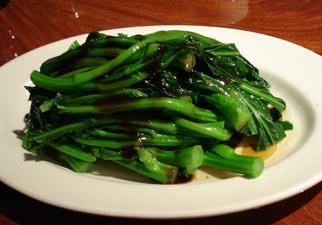Selection and storage
Choy sum, native to South China, stands as one of the most sought-after leafy vegetables in local markets throughout East Asia and Southeast Asia. Nowadays, it’s also readily available in specialty grocers and Asian markets across Europe, Australia, and the United States.
Choy sum offers versatility in harvesting, ranging from tender young greens to flowering tops. When young, its leaves possess a gentle flavor akin to spinach, while as it matures, the taste intensifies, resembling the pungency of mustard greens.
Choy sum is a cool-season crop. Fresh produce inundates markets, reaching its peak from fall through spring. Nevertheless, the availability of fresh produce year-round is also guaranteed, thanks to greenhouse farming practices.
When selecting choy sum at the market, opt for fresh, crisp, dark green leaves with smooth stalks and vibrant flowering tops, steering clear of any signs of wilting or discoloration.
Once at home, promptly refrigerate the leaves to maintain freshness. For optimal flavor and nutritional benefits, it is advisable to use fresh choy sum greens as soon as possible.
Choy sum can be stored for up to 3-4 days in cold storage conditions, ideally at temperatures between 5-8°C and with humidity levels exceeding 90%.
Preparation and serving methods
Choy sum is a common green leafy staple in Cantonese cuisine. Its fresh leaves, flower buds, and stems are used in a variety of cuisines across East Asia and in the West, where a significant Chinese diaspora exists.
Choy sum can be substituted for gai lan, mustard greens, broccoli rabe, etc., in similar cooked dishes.
Before cooking, thoroughly wash the leaves in clean running water to remove any sand or insecticide residues. Trim away thick petioles and stems.
Here are some serving ideas:
 |
| Choy sum stir fry in garlic sauce. Courtesy: Jonathan |
-
Grown-up choy sum stems and leaves may be preserved as a pickled vegetable. They are also fantastic when added to soups and stews or braised with aromatics such as rice wine, soy sauce, ginger, garlic, and spring onions.
-
Fresh tender choy sum greens are eaten raw in salads.
-
It complements well in soups and stir-fries with mushrooms, chicken, shrimp, and tofu.
-
Steam or blanch choy sum lightly to preserve both flavor and texture, then mix in garlic sauce and sprinkle with sesame seeds as a garnish.
-
Stir-fry whole or chopped choy sum in garlic oil and combine with oyster sauce.
Safety profile
-
Reheating leftovers of choy sum, along with other leafy greens like mustard greens and spinach, can lead to the conversion of nitrates into nitrites and nitrosamines by certain bacteria thriving on nitrate-rich foods. These toxic compounds pose potential harm to health.
-
Phytates and dietary fiber present in choy sum may interfere with the bioavailability of iron, calcium, and magnesium.
-
Choy sum, being a Brassica family vegetable, contains oxalic acid, a naturally occurring substance found in some vegetables that may crystallize as oxalate stones in the urinary tract in some people. People with known oxalate urinary tract stones are advised to avoid eating vegetables belonging to the Brassica family. Adequate intake of water is, therefore, necessary to maintain normal urine output.
-
Choy sum may also contain goitrogens, which may interfere with thyroid hormone production and can cause thyroxine hormone deficiency in individuals with thyroid dysfunction.
(Medical Disclaimer: The information and reference guides on this website are intended solely for the general information of the reader. It is not to be used to diagnose health problems or for treatment purposes. It is not a substitute for medical care provided by a licensed and qualified health professional. Please consult your health care provider for any advice on medications.)
You may also like to read ≻≻
≺≺ Back to Vegetables from Choy sum. Visit here for an impressive list of vegetables with complete illustrations of their nutrition facts and health benefits.
≺≺ Back to Home page.
Further reading:
-
Refer Stanford School of Medicine Cancer information Page- Nutrition to Reduce Cancer Risk (Link opens in new window).
-
Food Standards Australia & New Zealand.
-
Production Guide for Choy Sum—An Emerging Asian Vegetable in Florida –University of Florida-IFAS Extension (Link opens in new window).
-
Specialty Produce (Link opens in new window).

